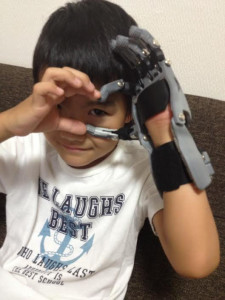
The first child to receive a 3D printed hand through e-NABLE was a South African boy named Liam, who was born missing the fingers on his right hand. After seeing a YouTube video about Liam’s story, a woman named Yukako discovered that the boy’s hand looked very similar to her son’s. This was in the fall of 2013, only months after the fledgling organization had made the files for Liam’s prosthetic available online, with the invitation for anyone to print it for themselves and/or make any improvements or alterations. Determined to print a hand for her son Seigo, Yukako began searching for someone who could help her.
Even though she lived in a city of over 2 million people, Yukako was unable to find anyone who knew anything about 3D printed assistive devices – which really goes to show how quickly things have advanced in the last three years. Undeterred, Yukako decided to just do it herself. She downloaded the files and ordered a print from a 3D printing company, who modified the device slightly to improve the grip and redesign the thumb, but it cost about $1,500, according to Yukako. She forged ahead anyway.
“I also downloaded the assembly instructions and took them to my son’s prosthetist and occupational therapist, where Seigo already practices with a myo-electric hand,” Yukako said. “I asked for his assistance to assemble and fit the 3D printed parts for my son. It was his first time making a 3D printed device and by April 2014, Seigo’s first hand was completed!”
Though Seigo could grasp objects and even throw a ball, there were still a lot of issues with the device. It was heavy, broke easily, and needed to be fixed several times over the course of that first year. Unwilling to accept that this was the best that could be done, Yukako contacted e-NABLE directly. By that time, the organization had already grown into a community of over 3,000 people, and she was connected to two volunteers in Japan.
“Mr. Kojima and Mr. Tobias listened to our story and took on the challenge to 3D print a better and stronger device for Seigo,” she said. ”We got the new hand last summer and it looks very cool, is much lighter and it is going very well so far!”
Seigo’s new hand is a modification of e-NABLE’s Cyborg Beast design, and he can now do anything, even tasks that require a great deal of flexibility and dexterity. He has mastered Cat’s Cradle, a game that many people with fully formed hands can’t even figure out (myself included). It’s amazing how fast e-NABLE has grown, and they’re a large part of why 3D printed prosthetics have come so far so quickly. Three years ago, Yukako wasn’t able to find anyone in her city who knew about 3D printed assistive devices; today, procuring a custom device is as easy as clicking a button. Discuss your thoughts on Seigo’s e-NABLE Cyborg Beast in the 3D Printed Hand forum over at 3DPB.com.
